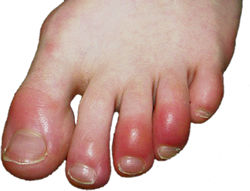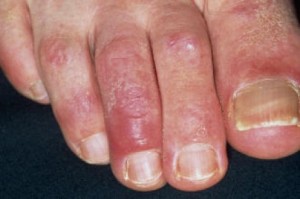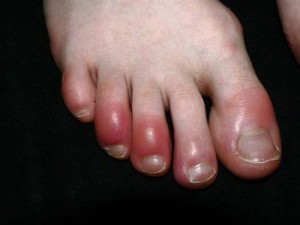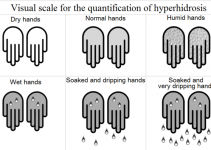Chilblains are common skin problems in people residing in cold regions. Read and know all about the causes, symptoms, diagnosis and treatment of this disease.
What is Chilblains?
Page Contents
These are red or purple lumps that arise on the skin surface due to painful swelling of tiny blood vessels as a reaction to sudden warming after exposure to very cold temperatures.
The condition is also referred to as “Pernio”.
Chilblains Symptoms
Some of the main potential signs and symptoms of this condition involve:
- Development of small, red patches over the skin (often on the hands or feet)
- Itchiness in the bumps
- Inflammation of blood vessels
- Development of blisters on ears, nose, toes and fingers
- Formation of blisters
- Inflamed appearance of the skin
- Changing of skin color from red to dark blue
- Pain in affected spots
- Burning sensation on bumps formed over the skin
- Possible ulceration
The bumps most commonly develop on the skin of the hands and feet. However, people may also get them on the nose or ears and on the lower extremities such as thighs and legs. Babies may find the swollen lumps arising on their wrists. Severe cases of the condition may also give rise to blisters on the skin surface that look similar to skin patches that have suffered a second or third degree burn.
What Causes Chilblains?
As aforesaid, these lumps are generally the result of an abnormal response of the body to cold temperatures. They tend to occur on skin regions that are exposed to cold and then brought to warm temperatures too soon. For example, coming from a cold exterior to heated interior and directly warming cold hands in front of a fire or heater can cause this problem. Rapid heating of extremely cold skin can cause expansion of small blood vessels beneath the skin surface. The tiny blood vessels can expand more rapidly than adjoining larger blood vessels can cope up with. It leads to a “bottleneck” situation with the blood leaking into tissues located close by. It is not known why the problem exactly occurs in some people more than others.
The condition is also more common in women. Men are found to be less likely to get chilblains. The reason for this is, again, not known.
Chilblains Diagnosis
General practitioners or chiropodists examine the affected region to look for obvious signs like redness and inflammation of the skin on the hands, feet or other extremities. The diagnosis is straightforward and mainly depends on physical observation of the symptoms. Doctors also ask whether the patient has recently been exposed to rapid changes in temperature.
Chilblains Treatment
Typically, treatment of Chilblains comprise of medications and lotions. Generally, this condition does not lead to permanent injury. If left untreated, however, it may cause severe damage and even lead to infection.
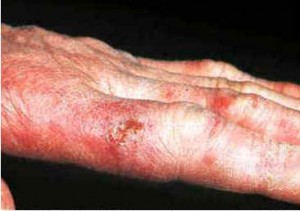
Picture 2 – Chilblains on Fingers
Medical treatment for the syndrome involves use of
Corticosteroid creams
These are useful in reducing swelling in the lumps and restore skin condition to normal. Topical corticosteroids can provide relief from inflammation and itching.
Blood pressure medications
A drug known as Nifedipine (Procardia, Adalat), which helps reduce blood pressure, helps open up blood vessels. This is the reason why it is used to treat Chilblains.
Chilblains Home Remedies
The skin lumps caused by this disease generally go away within 1-3 weeks. Within this period, home remedies may be used to alleviate the symptoms. These include:
Lotions
Inflammation and itchiness in the nodules can be relieved with the aid of topical application of lotions and ointments.
Cleaning wounds
Daily cleaning of wounds and protecting them from infection can also be quite effective, especially if the skin is broken. The skin area should be cleaned with an antiseptic solution to prevent an infection.
Applying warmth
Applying hot compresses over affected skin region can be helpful. However, you must keep the lesions away from sources of heat.
Avoiding scratching
Scratching the affected skin region may irritate it and even result in an infection.
Chilblains Risk Factors
Certain factors may increase the risk of having this skin disorder. These include:
Climatic conditions
Living in regions with extremely humid climate can increase the risk of rapid exposure of the skin to cold and heat. Ironically, people living in very cold and dry areas are less susceptible to this disease partly due to their clothing.
Body weight
People with a body weight about 20 percent less than normal, healthy individuals are also vulnerable to this problem.
Time of year
The time of the year is also supposed to be a deciding factor for this condition. This is due to the fact that Chilblains are more common between November and April.
Ill-fitting shoes
Wearing tight-fitting shoes and socks can put undue pressure on the skin and increase the vulnerability to this problem.
Poor circulation
Individuals suffering from poor blood circulation tend to show greater sensitivity towards changes in temperature. This makes them more susceptible to the disease.
Raynaud’s Phenomenon
Raynaud’s phenomenon is a condition that, like Chillblains, is associated to cold temperatures. The disease affects the extremities and gives rise to sores as well as changes in color of affected skin area. Individuals suffering from Raynaud’s phenomenon are more susceptible to Chilblains.
Chilblains Prognosis
The condition shows a good response to treatment and usually resolves within 1-3 weeks. With proper treatment, the blisters and bumps tend to go away in 1-2 weeks. However, there can be a seasonal recurrence of the disease for several years. Prognosis is good in cases where treatment is more preventive than curative.
Chilblains Complications
The condition may produce complications if blisters arise on the skin. In case of skin blisters, patients may suffer from ulcers and infections. If left untreated, infections can be painful as well as life-threatening. If you suspect an infection, visit a doctor and get yourself diagnosed as early as you can.
Chilblains Prevention
The best way to prevent this condition is to avoid its development in the first place. This can be done by measures like:
- Limiting exposure to cold
- Dressing in warm clothes
- Covering exposed skin surface while going outside in cold weather
- Keeping your surroundings comfortably warm
- Using sunscreen, even during cloudy days
If your skin gets exposed to cold temperatures, it is better to warm it gradually than exposing it to heat all of a sudden. Re-warming of cold skin may deteriorate the symptoms of the disease.
Chilblains Pictures
Take a peek at these Chilblains photos to know how the condition looks like. You may find these Chilblains images quite useful if you are intent on closely studying the physical appearance of the ailment.
If you suspect yourself to be having symptoms of Chilblains, immediately seek medical attention from your physician. If treated properly in time, the condition can resolve very fast and help you avoid any life-threatening complications that may arise in future.
References:
http://www.rightdiagnosis.com/c/chilblain/intro.htm
http://www.mayoclinic.com/health/chilblains/DS01091
http://www.epodiatry.com/chilblains.htm
http://www.medicalnewstoday.com/articles/172191.php

